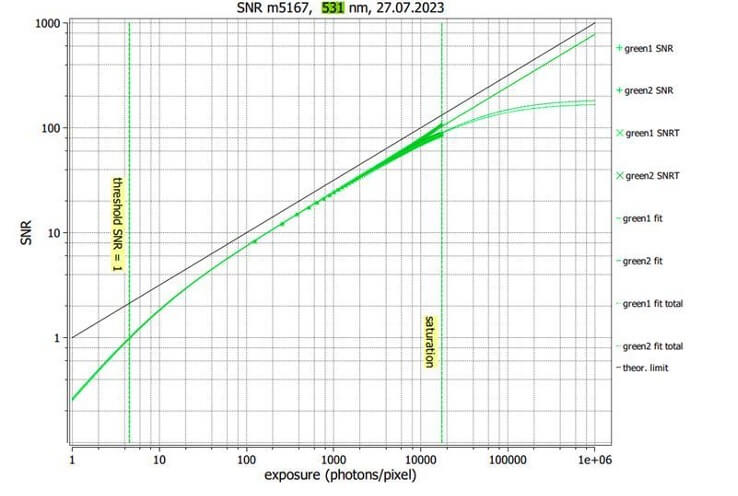What is exposure time?
The exposure time refers to the duration each pixel is exposed to light or photons. In medical imaging, exposure time directly impacts the quality of the captured images, Signal-to-Noise Ratio (SNR) and dynamic range.
Relationship between SNR and exposure time
Before exploring the advantages of long and short exposure times, it’s essential to grasp SNR and its connection to exposure time. The SNR, a vital metric in imaging, quantifies the quality of an image by comparing the signal strength to the level of effective noise. The formula for calculating the SNR is:
SNR = signal / effective noise
The effective noise, σEFF, is a combination of various noise sources in the imaging process, including dark noise, shot noise, and read noise.
Long exposure and high SNR
Longer exposure times inherently increase the number of photons collected, enhancing the signal strength. This leads to a higher SNR, resulting in images with improved clarity and finer details.
Short exposure and low SNR
Shorter exposures may contribute to a lower SNR due to the reduced accumulation of signal, resulting in relatively noisier images.
The below graph illustrates the relationship between exposure time and the SNR.

Effective noise and components
Effective noise, an integral aspect of SNR calculation, arises from various sources within the imaging process. The formula for calculating effective noise is:
Effective noise, σEFF = √(dark noise2 + shot noise2 + read noise2)
There are several components of noise.
The photon shot noise is the statistical noise associated with the arrival of photons at the pixel. Shot noise depends on the amount of photon flux, exposure period, and quantum efficiency.
S = (QE) * N * t
Where,
S – Signal level
N – flux of photons/second
QE – Quantum efficiency
t – exposure period
Shot noise = √S
Dark noise is a signal generated even when no photons are incident on the camera. This thermal phenomenon results from electrons spontaneously being generated within the silicon chip. The variations in the number of dark electrons collected during the exposure are the temporal dark noise.
Dark noise = √IDt
Where,
ID – Dark current
t – Exposure time
Relationship between dynamic range and exposure time
The camera’s performance depends on the dynamic range of the pixel, which is specified as the ratio of the maximum achievable signal to the camera noise. As the dynamic range of a camera increases, the ability to quantitatively measure the dimmest intensities in a scene increases.
The pixel full-well capacity determines the maximum signal strength, and the noise is the sum of dark and read noises. This is expressed in decibel units, as shown in this equation.

As discussed, the longer the exposure time, the more photons the sensor will receive, resulting in increased pixel intensity and a brighter image. Ideally, you want to use an exposure time that takes advantage of the full dynamic range without saturating any of the pixels to determine the correct exposure times.
Benefits of short and long exposure time in medical imaging
As exposure time emerges as one of the most critical parameters in fluorescence microscopy imaging, its impact on image quality becomes a focal point of consideration.
The longer exposure time brings about a notable increase in intensity values in the captured image, thereby contributing to high image quality. However, this benefit comes with a trade-off. Prolonged exposure times raise the chances of photo-bleaching and photo-toxicity. These molecules, which play a fundamental role in fluorescence, gradually decay due to the very long exposure necessary for inducing fluorescence.
Comparatively, opting for a shorter exposure time presents a solution to mitigate these concerns. Unfortunately, reducing exposure time drastically worsens the SNR and the image.
A high SNR is essential for very-low-light applications such as darkfield microscopy and fluorescence imaging. Striking a correct exposure time is essential for capturing intricate details, optimising SNR, and achieving accurate diagnoses. Similarly, in cell growth and division studies, longer exposure times can capture changes in cell morphology and behaviour over time.
How e-con Systems’ See3CAM_50CUG controls the exposure period
e-con Systems’ See3CAM_50CUG offers precise exposure control with exposure periods ranging from approximately 1 microsecond to extended seconds. It supports Multi-Frame set output mode, allowing varying gain values and exposure times for sequential frames, with a maximum number of frames that can be configured set at 4 for this feature. The See3CAM_50CUG’s capabilities are pivotal in enhancing image quality and extracting crucial details in various applications, including medical imaging.
One common use case is to trigger a light source and synchronise the sample’s excitation with the camera’s acquisition. By doing this, light is only exposed to the sample when the camera is acquiring images, reducing the photo-toxicity or photo-bleaching of the sample.
The See3CAM_50CUG brings forth two external trigger modes, each offering distinct exposure control advantages:
- Exposure control mode
In this mode, the pulse width of the trigger signal defines the exposure time of the sensor. The pulse width can be varied to achieve real-time adaptability and precision.

- Acquisition control mode
In this mode, image acquisition is triggered by an edge transition on the trigger pin. The exposure time can be configured through software, allowing seamless adjustments. The strobe output in this mode can be used to synchronise the light source with the camera’s exposure period.

See3CAM_50CUG’s versatile features and synchronisation not only improve the output image quality but also prioritises protecting sensitive sample. It comes in monochrome and colour variants.









